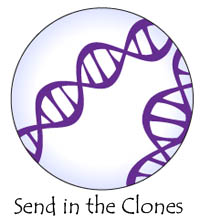Send In the Clones

Would a clone of yourself actually be you? People might tell you that you have your mother's eyes or your father's smile, or that your sister looks just like you did at her age. Why is that? You know that you are different in some ways from everyone in your family, but the fact remains that children look like their parents, just like you look like yours.
Children look like their parents because they share genetic material. The genetic material of a cell is called deoxyribonucleic acid, DNA for short. The genetic material of a cell acts as a blueprint for what we look like. Half of your DNA is from your mother and the other half is from your father. You have your mother's eyes because you have those genes, specific units of DNA, from her that control eye color and shape.
Those genes came to you when your mother's egg fused with your father's sperm. Egg and sperm are specialized cells for reproduction. These cells are called gametes. Gametes only contain half of the amount of DNA a cell must have to live. This is because they eventually come together and mix their DNA. The process of egg and sperm joining is called fertilization.
These cells only exist in special parts of the body used for reproduction. The rest of your body is made up of cells that have the entire DNA they must have to live. Those cells that are found outside the reproductive organs are called somatic cells. This word is easy to remember if you know that soma means body in another language.
Natural Clones
When an egg is fertilized with a sperm and the DNA mixes, the cell starts dividing. Dividing cells is the way we grow from one cell to many trillion cells, which is what you are right now. Sometimes, the dividing mass of cells splits into two masses of cells. Both masses keep dividing. The cells all have the same DNA. The two eventually grow into two kids with the same DNA. They are then known as identical twins.
These kids have the exact same DNA, which is exactly what a clone is. Yes, we already have human clones walking among us! Amazing right? Perhaps you know some identical twins? If you do, you might know that they might look the same, but they are very unique people in many ways. That is why a clone of you might not be you at all in the end. They might just be a separate, unique and beautiful person, like you, but different.
Read more about: Cloning Ewe
Bibliographic details:
- Article: Send in the Clones
- Author(s): Dr. Biology
- Publisher: Arizona State University School of Life Sciences Ask A Biologist
- Site name: ASU - Ask A Biologist
- Date published: 29 Sep, 2009
- Date accessed:
- Link: https://askabiologist.asu.edu/content/send-clones
APA Style
Dr. Biology. (Tue, 09/29/2009 - 22:03). Send in the Clones. ASU - Ask A Biologist. Retrieved from https://askabiologist.asu.edu/content/send-clones
Chicago Manual of Style
Dr. Biology. "Send in the Clones". ASU - Ask A Biologist. 29 Sep 2009. https://askabiologist.asu.edu/content/send-clones
Dr. Biology. "Send in the Clones". ASU - Ask A Biologist. 29 Sep 2009. ASU - Ask A Biologist, Web. https://askabiologist.asu.edu/content/send-clones
MLA 2017 Style

Would a clone of you really be you?
Be Part of
Ask A Biologist
By volunteering, or simply sending us feedback on the site. Scientists, teachers, writers, illustrators, and translators are all important to the program. If you are interested in helping with the website we have a Volunteers page to get the process started.

